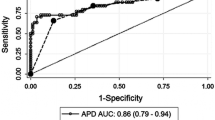Abstract
Purpose
The main criteria used for deciding on surgery in children with presumed antenatally detected pelviureteric junction obstruction (PPUJO) are the level of hydronephrosis (ultrasonography), the level of differential renal function (DRF) and the quality of renal drainage after a furosemide challenge (renography), the importance of each factor being far from generally agreed. Can we predict, on the basis of ultrasound parameters, the patient in whom radionuclide renography can be avoided?
Methods
We retrospectively analysed the medical charts of 81 consecutive children with presumed unilateral PPUJO detected antenatally. Ultrasound and renographic studies performed at the same time were compared. Anteroposterior pelvic diameter (APD) and calyceal size were both divided into three levels of dilatation. Parenchymal thickness was considered either normal or significantly decreased. Acquisition of renograms under furosemide stimulation provided quantification of DRF, quality of renal drainage and cortical transit.
Results
The percentages of patients with low DRF and poor drainage were significantly higher among those with major hydronephrosis, severe calyceal dilatation or parenchymal thinning. Moreover, impaired cortical transit, which is a major risk factor for functional decline, was seen more frequently among those with very severe calyceal dilatation. However, none of the structural parameters obtained by ultrasound examination was able to predict whether the level of renal function or the quality of drainage was normal or abnormal. Alternatively, an APD <30 mm, a calyceal dilatation of <10 mm and a normal parenchymal thickness were associated with a low probability of decreased renal function or poor renal drainage.
Conclusion
In the management strategy of patients with prenatally detected PPUJO, nuclear medicine examinations may be postponed in those with an APD <30 mm, a calyceal dilatation of <10 mm and a normal parenchymal thickness. On the contrary, precise estimation of DRF and renal cortical transit should be performed in patients with APD >30 mm, major calyceal dilatation and/or parenchymal thinning.
Similar content being viewed by others
References
Piepsz A, Gordon I, Brock 3rd J, Koff S. Round table on the management of renal pelvic dilatation in children. J Pediatr Urol. 2009;5:437–44.
Caldamone AA, Palmer JS, Mouriquand P, et al. Ureteropelvic junction obstruction: contemporary approaches to several case scenarios. Dialogues Pediatr Urol. 2010;31:1–7.
Ismaili K, Avni FE, Piepsz A, Wissing KM, Cochat P, Aubert D, et al. Current management of infants with fetal renal pelvis dilation: a survey by French-speaking pediatric nephrologists and urologists. Pediatr Nephrol. 2004;19:966–71.
Gordon I, Piepsz A, Sixt R. Guidelines for standard and diuretic renogram in children. Eur J Nucl Med Mol Imaging. 2011;38:1175–88.
Ismaili K, Piepsz A. The antenatally detected pelvi-ureteric junction stenosis: advances in renography and strategy of management. Pediatr Radiol. 2013;43:428–35.
Piepsz A, Kuyvenhoven JD, Tondeur M, Ham H. Normalized residual activity: usual values and robustness of the method. J Nucl Med. 2002;43:33–8.
Tondeur M, Nogarede C, Donoso G, Piepsz A. Inter- and intra-observer reproducibility of quantitative renographic parameters of differential function and renal drainage in children. Scand J Clin Lab Investig. 2013;73:414–21.
Conway JJ, Maizels M. The “well tempered” diuretic renogram: a standard method to examine the asymptomatic neonate with hydronephrosis or hydroureteronephrosis. A report from combined meetings of The Society for Fetal Urology and members of The Pediatric Nuclear Medicine Council-The Society of Nuclear Medicine. J Nucl Med. 1992;33:2047–51.
Ulman I, Jayanthi VR, Koff SA. The long-term follow-up of newborns with severe unilateral hydronephrosis initially treated nonoperatively. J Urol. 2000;164:1101–5.
Nogarède C, Tondeur M, Piepsz A. Normalized residual activity and output efficiency in case of early furosemide injection in children. Nucl Med Commun. 2010;31:355–8.
Schlotmann A, Clorius JH, Clorius SN. Diuretic renography in hydronephrosis: renal tissue tracer transit predicts functional course and thereby need for surgery. Eur J Nucl Med Mol Imaging. 2009;36:1665–73.
Piepsz A, Tondeur M, Nogarède C, Collier F, Ismaili K, Hall M, et al. Can severely impaired cortical transit predict which children with pelvi-ureteric junction stenosis detected antenatally might benefit from pyeloplasty? Nucl Med Commun. 2011;32:199–205.
Duong HP, Piepsz A, Collier F, Khelif K, Christophe C, Cassart M, et al. Predicting the clinical outcome of antenatally detected unilateral pelviureteric junction stenosis. Urology. 2013;82:691–6.
Fernbach SK, Maizels M, Conway JJ. Ultrasound grading of hydronephrosis: introduction to the system used by the Society of fetal Urology. Pediatr Radiol. 1993;23:478–80.
Onen A. An alternative grading system to refine the criteria for severity of hydronephrosis and optimal treatment guidelines in neonates with primary UPJ-type hydronephrosis. J Pediatr Urol. 2007;3:200–5.
Kadioglu A. Renal measurements, including length, parenchymal thickness, and medullary pyramid thickness, in healthy children: what are the normative ultrasound values? Am J Roentgenol. 2010;194:509–15.
Dhillon HK. Prenatally diagnosed hydronephrosis: the Great Ormond Street experience. Br J Urol. 1998;81(2):39–44.
Koff SA. The beneficial and protective effects of hydronephrosis. APMIS. 2003;109:7–12.
Nitzsche EU, Zimmerhackl LB, Hawkins RA, Stöver B, Frankenschmidt A, Sigmund G, et al. Correlation of ultrasound and renal scintigraphy in children with unilateral hydronephrosis in primary workup. Pediatr Nephrol. 1993;7:138–42.
Beland MD, Walle NL, Machan JT, Cronan JJ. Renal cortical thickness measured at ultrasound: is it better than renal length as an indicator of renal function in chronic kidney disease? Am J Roentgenol. 2010;195:146–9.
Lødrup AB, Karstoft K, Dissing TH, Nyengaard JR, Pedersen M. The association between renal function and structural parameters: a pig study. BMC Nephrol. 2008;9:18.
Ng CF, Chan LW, Wong KT, Cheng CW, Yu SC, Wong WS. Prediction of differential creatinine clearance in chronically obstructed kidneys by non-contrast helical computerized tomography. Int Braz J Urol. 2004;30:102–8.
Conflicts of interest
None.
Author information
Authors and Affiliations
Corresponding author
Additional information
Khalid Ismaili and Amy Piepsz share senior authorship.
Rights and permissions
About this article
Cite this article
Duong, H.P., Piepsz, A., Khelif, K. et al. Transverse comparisons between ultrasound and radionuclide parameters in children with presumed antenatally detected pelvi-ureteric junction obstruction. Eur J Nucl Med Mol Imaging 42, 940–946 (2015). https://doi.org/10.1007/s00259-014-2965-6
Received:
Accepted:
Published:
Issue Date:
DOI: https://doi.org/10.1007/s00259-014-2965-6




